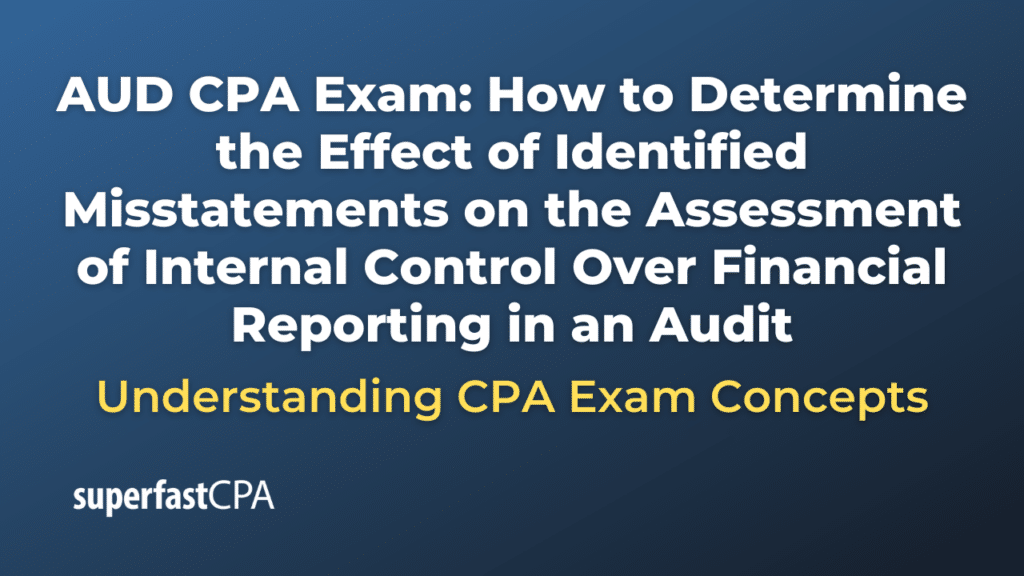Introduction
Purpose of the Article
In this article, we’ll cover how to determine the effect of identified misstatements on the assessment of internal control over financial reporting in an audit. Understanding the relationship between identified misstatements and the assessment of internal control over financial reporting (ICFR) is a critical aspect of the audit process. ICFR plays a fundamental role in ensuring that a company’s financial statements are accurate, complete, and compliant with applicable accounting standards. When an auditor identifies misstatements during an audit, these findings can directly impact their evaluation of ICFR.
Misstatements, whether caused by error or fraud, may indicate weaknesses or deficiencies in the company’s internal controls. For example, a significant misstatement might suggest that a key control did not operate effectively, raising concerns about the reliability of the financial reporting process. By understanding how identified misstatements relate to ICFR, auditors can better assess the overall effectiveness of the internal controls and determine the appropriate response, which may include revising audit procedures or communicating concerns to management and those charged with governance.
In essence, the ability to evaluate the effect of misstatements on ICFR is vital for auditors to form an accurate opinion on the financial statements and provide reasonable assurance that the financial reporting is free from material misstatement. This knowledge not only enhances the quality of the audit but also ensures that stakeholders, including investors and regulators, have confidence in the financial information presented by the company.
Relevance to the AUD CPA Exam
The relationship between misstatements and ICFR is a key topic within the AUD section of the CPA exam. This exam assesses a candidate’s ability to understand and apply auditing concepts, including the evaluation of internal controls and the identification of misstatements. Candidates must demonstrate proficiency in how these concepts interact and influence the audit process.
Given the importance of ICFR in financial reporting, the AUD CPA exam places significant emphasis on testing candidates’ understanding of how identified misstatements can affect the auditor’s assessment of ICFR. This includes evaluating the severity of the misstatements, determining whether they indicate control deficiencies, and deciding on the necessary adjustments to the audit plan.
Mastery of this topic is essential for CPA candidates, as it reflects a deeper understanding of the audit process and prepares them for real-world scenarios where they will need to make informed judgments about the impact of misstatements on internal controls. By studying this topic, candidates will be better equipped to perform audits that comply with professional standards and protect the integrity of financial reporting.
Understanding Internal Control Over Financial Reporting (ICFR)
Definition and Purpose of ICFR
Internal Control Over Financial Reporting (ICFR) refers to the processes and procedures that a company implements to ensure the accuracy, reliability, and compliance of its financial statements. These controls are designed to provide reasonable assurance that the financial reporting is free from material misstatements, whether due to error or fraud.
The primary purpose of ICFR is to support the integrity of a company’s financial reporting by establishing a framework of checks and balances within the organization. This framework includes policies and procedures that cover various aspects of financial operations, such as transaction processing, account reconciliation, and financial statement preparation. By having robust internal controls, companies can prevent, detect, and correct errors or irregularities in a timely manner, thereby maintaining the trust of investors, regulators, and other stakeholders.
ICFR is critical in ensuring that financial statements are prepared in accordance with Generally Accepted Accounting Principles (GAAP) or other relevant accounting standards. It also helps to safeguard assets from unauthorized use or disposition and ensures that financial transactions are properly authorized and recorded.
In the context of an audit, the auditor assesses the design and operating effectiveness of ICFR to determine whether it is capable of preventing or detecting material misstatements. This evaluation forms the basis for the auditor’s opinion on the effectiveness of the internal controls, which is often required as part of the audit report, particularly for public companies subject to the Sarbanes-Oxley Act (SOX).
The strength of a company’s ICFR directly impacts the reliability of its financial reporting. Strong internal controls provide confidence that the financial statements present a true and fair view of the company’s financial position and performance. Conversely, weaknesses or deficiencies in ICFR may result in financial statements that are inaccurate or misleading, which can have serious consequences for the company, including loss of investor confidence, regulatory penalties, and legal liability.
Understanding the definition and purpose of ICFR is essential for auditors, as it underpins the entire audit process. By ensuring that ICFR is effectively designed and operating, auditors help to uphold the quality and credibility of financial reporting, which is fundamental to the functioning of capital markets.
Components of ICFR
The Committee of Sponsoring Organizations of the Treadway Commission (COSO) framework is widely recognized as the standard for designing and evaluating internal control systems, including Internal Control Over Financial Reporting (ICFR). According to the COSO framework, ICFR is composed of five interrelated components that work together to provide reasonable assurance that a company’s financial reporting is accurate and reliable. These components are:
Control Environment
The Control Environment sets the foundation for the internal control system within an organization. It represents the collective attitude, awareness, and actions of the board of directors, management, and employees regarding the importance of internal controls. The control environment is influenced by factors such as the company’s ethical values, integrity, commitment to competence, and the structure and authority of management.
Key elements of a strong control environment include:
- Ethical Culture: Promoting a culture of honesty and ethical behavior.
- Leadership Tone: The board and management demonstrate their commitment to internal controls by setting the “tone at the top.”
- Organizational Structure: Clearly defined lines of authority and responsibility.
- Human Resources Practices: Ensuring that employees are competent and understand their role in the internal control system.
A robust control environment is crucial as it affects the overall effectiveness of the other components of ICFR.
Risk Assessment
Risk Assessment involves identifying and analyzing the risks that could prevent the company from achieving its financial reporting objectives. This process helps the company understand where potential misstatements could arise and determine how these risks should be managed.
Key aspects of risk assessment include:
- Identification of Risks: Recognizing risks that could result in material misstatements in financial reporting, including risks due to external factors (e.g., economic conditions) and internal factors (e.g., changes in management or information systems).
- Analysis of Risks: Evaluating the likelihood and potential impact of identified risks.
- Risk Response: Deciding on actions to mitigate risks, such as implementing new controls or enhancing existing ones.
Risk assessment is an ongoing process, as the company’s environment, operations, and other factors that affect risk can change over time.
Control Activities
Control Activities are the specific actions taken by a company to mitigate the risks identified during the risk assessment process. These activities ensure that management’s directives to reduce risks to an acceptable level are carried out effectively. Control activities can take many forms, including preventive and detective controls.
Examples of control activities include:
- Segregation of Duties: Dividing responsibilities among different employees to reduce the risk of errors or fraud.
- Authorization Procedures: Ensuring that transactions are properly authorized before being executed.
- Reconciliations: Regularly comparing different sets of data (e.g., bank statements with accounting records) to identify and correct discrepancies.
- Physical Controls: Protecting assets through measures such as secure access and inventory counts.
Control activities are essential for ensuring that risks are effectively managed and that the company’s financial reporting is accurate and complete.
Information and Communication
Information and Communication refers to the systems and processes used to capture, process, and report financial information, as well as the ways in which this information is communicated within the organization and to external parties. Effective information and communication systems ensure that relevant information is identified, captured, and communicated in a timely manner.
Key components of information and communication include:
- Information Systems: The technology and processes used to gather and process financial data, ensuring it is accurate, complete, and timely.
- Internal Communication: Ensuring that employees at all levels receive the information they need to fulfill their responsibilities, particularly regarding the operation of internal controls.
- External Communication: Providing stakeholders, such as investors and regulators, with accurate and reliable financial information.
Effective communication supports all other components of ICFR by ensuring that relevant information flows through the organization and is accessible to those who need it.
Monitoring Activities
Monitoring Activities involve ongoing evaluations of the internal control system to ensure it is operating as intended. These evaluations help to identify and correct control deficiencies in a timely manner, ensuring that the ICFR remains effective in mitigating risks to financial reporting.
There are two types of monitoring activities:
- Ongoing Monitoring: Regular activities, such as management reviews and reconciliations, that provide continuous feedback on the operation of internal controls.
- Separate Evaluations: Periodic assessments, such as internal audits, that provide an independent evaluation of the effectiveness of internal controls.
Monitoring is critical to maintaining a strong internal control system, as it allows the organization to adapt to changes in the environment and address new risks as they arise.
Each of these five components is integral to the effectiveness of ICFR. Together, they create a comprehensive system that helps ensure the accuracy and reliability of a company’s financial reporting, thereby supporting the integrity of the financial statements and the trust of stakeholders.
Role of the Auditor in Evaluating ICFR
The auditor’s responsibility in evaluating Internal Control Over Financial Reporting (ICFR) is a crucial aspect of the audit process. The auditor’s primary objective is to obtain reasonable assurance that the financial statements are free from material misstatement, whether due to error or fraud. To achieve this, the auditor must assess the design and operating effectiveness of a company’s ICFR.
Assessing the Design of ICFR
The design assessment involves evaluating whether the internal controls are appropriately designed to prevent, or detect and correct, material misstatements in the financial statements. This process includes understanding the flow of transactions within the company, identifying key controls related to significant accounts and disclosures, and determining whether these controls, if operating as designed, would be effective in addressing identified risks.
Key steps in assessing the design of ICFR include:
- Understanding the Entity’s Control Environment: The auditor assesses the overall tone at the top, the company’s commitment to ethical values, and the effectiveness of governance structures.
- Identifying Key Controls: The auditor identifies controls that are significant to financial reporting, focusing on those related to areas with a high risk of material misstatement.
- Evaluating Control Design: The auditor examines whether the controls are suitably designed to address specific risks, considering factors such as the nature of the transaction, the complexity of the process, and the potential for errors or fraud.
A well-designed control environment, along with specific control activities, provides a foundation for reliable financial reporting. However, design alone is not sufficient; the auditor must also evaluate whether these controls are operating effectively.
Assessing the Operating Effectiveness of ICFR
The operating effectiveness assessment involves testing whether the key controls identified during the design assessment are functioning as intended throughout the period under audit. This step ensures that the controls are not only designed correctly but are also being consistently applied by the company’s personnel.
The auditor’s procedures for assessing operating effectiveness typically include:
- Test of Controls: The auditor performs tests to determine whether the controls have been applied as designed at relevant times during the audit period. These tests might include inquiries of personnel, inspection of documents, observation of control activities, and re-performance of procedures.
- Sampling: In some cases, the auditor may select a sample of transactions to test the effectiveness of controls over a period, rather than testing every transaction.
- Evaluation of Control Deficiencies: If the auditor identifies instances where controls did not operate effectively, they must evaluate the severity of these deficiencies. This evaluation considers whether the deficiency could result in a material misstatement and whether it is indicative of a significant deficiency or material weakness in ICFR.
The results of the auditor’s tests of controls are critical in determining the nature, timing, and extent of substantive audit procedures. If controls are found to be effective, the auditor may be able to rely on them to reduce the extent of substantive testing. Conversely, if controls are ineffective, the auditor may need to perform additional substantive procedures to gather sufficient audit evidence.
Reporting on ICFR
For public companies subject to the Sarbanes-Oxley Act (SOX), the auditor is also required to issue an opinion on the effectiveness of the company’s ICFR. This involves not only assessing the design and operating effectiveness of controls but also providing an overall evaluation of the ICFR as a whole.
Key points in reporting on ICFR include:
- Material Weaknesses: If the auditor identifies one or more material weaknesses in ICFR, they must conclude that ICFR is not effective and communicate these findings to management and those charged with governance.
- Unqualified Opinion: If no material weaknesses are identified and the controls are found to be effective, the auditor can issue an unqualified opinion on ICFR, indicating that the company’s controls are effective in all material respects.
- Qualified or Adverse Opinion: If material weaknesses are identified and not remediated by the end of the audit period, the auditor may issue a qualified or adverse opinion on ICFR.
The auditor’s evaluation of ICFR is essential not only for forming an opinion on the financial statements but also for ensuring that stakeholders have confidence in the company’s financial reporting process. By thoroughly assessing the design and operating effectiveness of ICFR, auditors help to identify and address risks of material misstatement, ultimately contributing to the reliability and transparency of financial information.
Identifying and Evaluating Misstatements
Definition of Misstatements
A misstatement in the context of financial reporting refers to a discrepancy or error in the financial statements that causes the reported financial information to deviate from the actual financial condition or results of the company. Misstatements can arise from inaccuracies in data, omissions, or misapplication of accounting principles. They can occur due to either unintentional errors or intentional actions (fraud).
Misstatements are typically classified into three categories: factual misstatements, judgmental misstatements, and projected misstatements. Each type has distinct characteristics and implications for the auditor’s assessment of the financial statements.
Factual Misstatements
Factual misstatements are those that involve a clear and objective error in the financial statements. These are discrepancies where there is no ambiguity or subjective judgment involved; the misstatement is based on verifiable evidence that contradicts the reported amounts or disclosures.
Examples of factual misstatements include:
- Incorrect Calculation: A mathematical error in totaling figures within the financial statements.
- Data Entry Errors: Recording an incorrect amount due to a typo or data entry mistake.
- Misclassification: An item recorded in the wrong account, such as classifying a current liability as a non-current liability.
Factual misstatements are generally straightforward to identify and correct, as they are based on observable and definitive information.
Judgmental Misstatements
Judgmental misstatements arise when there is a difference in judgment between the auditor and management regarding the appropriateness of an accounting estimate or the selection of accounting policies. These misstatements often involve areas where estimates or subjective judgments are required, and they reflect the auditor’s view that management’s estimates or assumptions are not reasonable.
Examples of judgmental misstatements include:
- Overly Aggressive Estimates: Management’s estimate of bad debt expense may be overly optimistic, leading to an understatement of the allowance for doubtful accounts.
- Inappropriate Accounting Policies: Management may choose an accounting method that the auditor believes is not the most appropriate under the circumstances, leading to a potential misstatement.
Judgmental misstatements can be more complex to address, as they often involve professional judgment and may require detailed discussions between the auditor and management to reach a resolution.
Projected Misstatements
Projected misstatements are the auditor’s estimates of misstatements in a population, based on the results of audit sampling. When auditors test a sample of transactions or balances, they may identify misstatements within that sample. Projected misstatements involve extrapolating the identified errors in the sample to estimate the total misstatement in the entire population.
For example:
- If an auditor identifies a $10,000 error in a sample that represents 10% of the total transactions, they might project that the total misstatement in the entire population could be $100,000.
Projected misstatements are particularly relevant when the auditor uses sampling methods to test large populations. The accuracy of projected misstatements depends on the representativeness of the sample and the reliability of the extrapolation method.
Importance of Understanding Misstatements
Understanding the different types of misstatements is crucial for auditors as it influences their approach to identifying, evaluating, and responding to potential errors or fraud in the financial statements. By categorizing misstatements as factual, judgmental, or projected, auditors can better assess the significance of the misstatements, determine their impact on the financial statements, and decide on the appropriate audit response. This understanding ultimately helps in forming an accurate and fair opinion on the financial statements, ensuring that stakeholders receive reliable financial information.
Common Causes of Misstatements
Misstatements in financial statements can arise from various sources, each with different implications for the accuracy and reliability of the financial reporting. Understanding these common causes is essential for auditors to identify and address potential issues during the audit process. The primary sources of misstatements include errors, fraud, and deficiencies in Internal Control Over Financial Reporting (ICFR).
Errors
Errors are unintentional mistakes in financial reporting that can occur at any stage of the accounting process. These mistakes can result from human error, system malfunctions, or misunderstandings of accounting principles. Errors are typically the most common cause of misstatements and can be relatively straightforward to detect and correct, although some errors may go unnoticed without a thorough audit.
Common types of errors include:
- Data Entry Mistakes: Simple clerical errors, such as transposing numbers or entering incorrect amounts, can lead to significant discrepancies in financial statements.
- Misapplication of Accounting Principles: Errors can occur when accounting principles are incorrectly applied, such as misclassifying expenses as capital expenditures or using an incorrect method for revenue recognition.
- Omissions: Failure to record a transaction or disclosure can result in incomplete financial statements, leading to material misstatements.
- Calculation Errors: Mistakes in calculating totals, percentages, or other figures can cause errors in reported financial data.
While errors are unintentional, they can still have a significant impact on the financial statements and must be identified and corrected by the auditor.
Fraud
Fraud refers to intentional acts by one or more individuals within or outside the organization to deceive stakeholders, often for financial gain. Fraudulent activities can result in material misstatements that significantly distort the financial statements, potentially misleading investors, creditors, and regulators.
There are two primary types of fraud that can lead to misstatements:
- Fraudulent Financial Reporting: This type of fraud involves deliberately manipulating financial records to present a more favorable financial position or performance. Examples include inflating revenue, understating expenses, or manipulating asset valuations. Management may engage in fraudulent financial reporting to meet earnings targets, secure financing, or increase stock prices.
- Misappropriation of Assets: This type of fraud involves the theft or misuse of an organization’s assets. Examples include embezzlement of funds, theft of inventory, or unauthorized use of company resources. While misappropriation of assets typically affects specific accounts, it can also indicate broader weaknesses in the internal control system.
Fraud is particularly concerning for auditors because it often involves deliberate attempts to conceal misstatements, making it more challenging to detect. Auditors must maintain professional skepticism and carefully evaluate the risk of fraud when planning and conducting an audit.
Deficiencies in ICFR
Deficiencies in Internal Control Over Financial Reporting (ICFR) are another common source of misstatements. A deficiency in ICFR exists when the design or operation of a control does not allow management or employees to prevent, or detect and correct, misstatements on a timely basis. These deficiencies can vary in severity, ranging from control weaknesses that pose minimal risk to material weaknesses that could result in significant misstatements.
Types of ICFR deficiencies include:
- Design Deficiencies: These occur when a control is missing or not properly designed to address the identified risks. For example, a company may lack adequate segregation of duties, allowing one employee to handle both recording and reconciling transactions, which increases the risk of undetected errors or fraud.
- Operational Deficiencies: These occur when a control is designed appropriately but is not operating as intended. For instance, if a reconciliation control is not performed regularly or is done inaccurately, it could result in undetected misstatements.
- Lack of Monitoring: Ineffective monitoring activities can lead to deficiencies in ICFR, as issues with control activities may go unnoticed. Without proper oversight, deficiencies can persist and result in material misstatements over time.
Deficiencies in ICFR are particularly critical because they may allow errors or fraud to occur without detection. Auditors must carefully evaluate the design and operating effectiveness of controls to identify potential deficiencies and assess their impact on the financial statements.
Importance of Addressing Common Causes of Misstatements
Recognizing the common causes of misstatements is vital for auditors as it informs their risk assessment and audit strategy. By understanding whether misstatements are likely to arise from errors, fraud, or deficiencies in ICFR, auditors can tailor their procedures to effectively address these risks. This proactive approach helps to ensure that the financial statements are free from material misstatements, thereby enhancing the credibility and reliability of the financial reporting process.
Procedures for Identifying Misstatements
Auditors employ a variety of procedures to identify misstatements in financial statements. These procedures are designed to gather sufficient, appropriate audit evidence to detect errors or fraud that could result in material misstatements. The two primary categories of audit procedures for identifying misstatements are testing controls and substantive testing.
Testing Controls
Testing controls involves evaluating the design and operating effectiveness of a company’s internal controls over financial reporting (ICFR). The purpose of this testing is to determine whether the controls are effective in preventing, or detecting and correcting, material misstatements in the financial statements.
Key procedures for testing controls include:
- Inquiry: Auditors interview management and employees to understand how controls are designed and implemented. These inquiries help the auditor assess whether controls are appropriately designed to mitigate the identified risks.
- Observation: Auditors observe the application of controls in real-time to ensure that they are operating as intended. For example, an auditor might observe the process of reconciling bank statements or authorizing transactions to verify that the control activities are being performed correctly.
- Inspection of Documents: Auditors review documentation that supports the operation of controls, such as reconciliations, approval signatures, and audit trails. This procedure helps auditors confirm that controls have been applied consistently and appropriately over the audit period.
- Re-performance: Auditors independently execute the control activity to verify that it operates effectively. For instance, an auditor might re-perform a reconciliation or recalculate a financial statement amount to confirm the accuracy of the control.
Testing controls is particularly important when the auditor plans to rely on the effectiveness of controls to reduce the extent of substantive testing. If controls are found to be operating effectively, the auditor may decide to perform less extensive substantive procedures. Conversely, if controls are deficient, the auditor may need to increase the scope of substantive testing to gather sufficient evidence.
Substantive Testing
Substantive testing involves directly verifying the amounts and disclosures in the financial statements to detect material misstatements. This testing is essential for providing the auditor with evidence about the completeness, accuracy, and validity of the financial statement items. Substantive procedures are generally performed when there is a high risk of material misstatement, or when controls are not deemed effective.
Substantive testing includes two main types of procedures:
- Substantive Analytical Procedures: These procedures involve evaluating financial information by examining relationships among financial and non-financial data. Auditors develop expectations based on historical data, industry trends, or other relevant factors, and then compare these expectations to the actual reported amounts. Significant differences may indicate potential misstatements that require further investigation. Examples of substantive analytical procedures include:
- Comparing current period revenue to prior periods and investigating significant variances.
- Analyzing the relationship between expenses and revenue to identify unusual trends.
- Comparing the company’s financial ratios to industry benchmarks.
- Tests of Details: These procedures involve directly verifying individual transactions, account balances, and disclosures. Tests of details provide the most direct evidence regarding the accuracy and completeness of specific items in the financial statements. Examples of tests of details include:
- Vouching: Tracing financial statement amounts back to source documents, such as invoices, contracts, or bank statements, to verify their accuracy and existence.
- Confirmation: Sending requests to third parties, such as customers or banks, to confirm balances or transactions reported by the company.
- Physical Inspection: Counting physical assets, such as inventory, to verify their existence and condition.
Substantive testing is crucial when there is a higher risk of material misstatement, or when the auditor is unable to rely on the effectiveness of controls. These procedures help auditors obtain sufficient evidence to form an opinion on the financial statements.
Importance of Comprehensive Audit Procedures
By combining testing controls with substantive testing, auditors can comprehensively evaluate the accuracy and reliability of financial statements. Testing controls provides insight into the company’s internal processes and their effectiveness in preventing or detecting misstatements, while substantive testing directly examines the financial data for potential errors or fraud.
These procedures ensure that auditors gather enough evidence to identify and evaluate misstatements, enabling them to provide stakeholders with a fair and accurate assessment of the company’s financial health.
Assessing the Impact of Identified Misstatements on ICFR
Evaluating the Severity of Misstatements
When assessing the impact of identified misstatements on Internal Control Over Financial Reporting (ICFR), auditors must evaluate the severity of each misstatement. The severity of a misstatement is a critical factor in determining whether the ICFR is effective or whether there are significant deficiencies or material weaknesses that need to be addressed. The following criteria are typically used to assess the severity of a misstatement:
Magnitude
Magnitude refers to the size or financial impact of the misstatement on the financial statements. A larger misstatement is more likely to be considered severe, especially if it approaches or exceeds the materiality threshold established by the auditor. The magnitude is often assessed in relation to the total assets, revenues, or other relevant financial metrics.
For example, a misstatement of $10,000 in a company with billions in revenue may be considered insignificant, whereas the same amount could be highly material for a small business. Auditors assess the magnitude of the misstatement to determine whether it could influence the economic decisions of users relying on the financial statements.
Frequency
Frequency considers how often the misstatement occurs. A misstatement that occurs repeatedly or consistently over time may indicate a more serious issue with the company’s internal controls compared to a one-time error. Recurrent misstatements suggest that the control environment may not be effectively preventing or detecting similar errors, thereby increasing the risk of material misstatements in the financial statements.
For example, if the auditor identifies that revenue is consistently overstated due to the same error each quarter, this would likely be considered a more severe issue than a single instance of overstated revenue.
Likelihood of Causing a Material Misstatement
Likelihood evaluates the probability that the identified misstatement could lead to a material misstatement in the financial statements if not corrected. Even if the magnitude of a current misstatement is relatively small, its potential to cause a material misstatement in the future is a key consideration.
Auditors assess factors such as:
- Trends: Is the misstatement likely to grow over time or affect other areas of the financial statements?
- Control Gaps: Are there weaknesses in ICFR that could allow this type of misstatement to recur or escalate?
- Potential Impact: Could the misstatement, if left uncorrected, significantly distort the financial statements?
A misstatement with a high likelihood of leading to a material misstatement in the future is considered more severe and may indicate a deficiency in ICFR.
Considering the Source and Nature of Misstatements
Beyond the severity of the misstatement, auditors must also consider the source and nature of the misstatement, as these factors provide insight into potential weaknesses in the internal control system and the overall reliability of financial reporting.
Isolated Error vs. Systematic Issue
Isolated Error: An isolated error is a one-time mistake that does not appear to be part of a broader pattern. Isolated errors may arise from human error, such as a data entry mistake or a one-off misapplication of accounting principles. While isolated errors can still be material, they generally suggest that the company’s internal controls are functioning effectively in most cases.
For example, if an auditor finds a single instance where an invoice was misclassified but no other similar errors are found, this may be considered an isolated error. In such cases, the impact on ICFR is usually limited, and the auditor may conclude that the overall control environment is still effective.
Systematic Issue: A systematic issue, on the other hand, indicates a recurring problem that may be rooted in a fundamental weakness in the internal controls. Systematic issues often result from inadequate control design, lack of oversight, or failure to implement key controls across the organization.
For example, if the auditor identifies multiple instances where revenues are consistently recognized prematurely due to flawed revenue recognition procedures, this suggests a systematic issue. Such issues are more concerning because they indicate that the ICFR is not adequately addressing the risks of material misstatement, potentially leading to significant deficiencies or material weaknesses.
Implications for ICFR Assessment
- Isolated Errors: When a misstatement is determined to be an isolated error, the auditor may conclude that the overall effectiveness of ICFR remains intact. However, the auditor will still assess whether the error highlights any potential areas for improvement in the control environment.
- Systematic Issues: If a misstatement is part of a broader systematic issue, the auditor is likely to assess this as a more severe deficiency in ICFR. Systematic issues typically suggest that the internal controls are not effectively mitigating the risks of material misstatement, leading to a higher likelihood of significant deficiencies or material weaknesses being reported.
By considering both the severity and the nature of identified misstatements, auditors can make informed judgments about the effectiveness of ICFR and the need for any remedial actions. This process is essential for ensuring the accuracy and reliability of financial reporting, thereby supporting stakeholder confidence in the financial statements.
Impact on Control Environment
The control environment is the foundation of an organization’s internal control system, influencing the overall tone and culture regarding the importance of internal controls. When auditors identify misstatements, these can be indicative of underlying weaknesses in the control environment, which may significantly affect the auditor’s assessment of Internal Control Over Financial Reporting (ICFR).
Indicators of Weaknesses in the Control Environment
Misstatements may suggest that the control environment does not effectively promote accountability, integrity, or a strong commitment to accurate financial reporting. Specific indicators of such weaknesses include:
- Management Override of Controls: If misstatements result from management overriding established controls, it signals a fundamental issue in the control environment. This behavior undermines the reliability of ICFR and suggests that controls may not be consistently applied.
- Inadequate Ethical Standards: Frequent or significant misstatements may indicate that ethical standards are not sufficiently emphasized or enforced within the organization, leading to a culture where errors or fraud can occur.
- Lack of Competence or Training: If misstatements are due to recurring errors or misunderstandings of accounting principles, it may reflect inadequate training or a lack of competence among key personnel, which is a direct reflection of weaknesses in the control environment.
When misstatements point to such weaknesses, auditors may conclude that the control environment is not strong enough to support effective ICFR. This can lead to a more cautious approach in the audit, with an increased focus on testing controls and performing substantive procedures to gather sufficient evidence.
Impact on Control Activities
Control activities are the specific policies and procedures implemented by an organization to address identified risks and ensure that management directives are carried out. Misstatements can reveal deficiencies in these control activities, which are critical for maintaining the integrity of financial reporting.
Common Deficiencies Revealed by Misstatements
Misstatements often highlight specific areas where control activities are not functioning as intended, including:
- Lack of Segregation of Duties: A common issue is the absence of proper segregation of duties, where one individual has control over multiple aspects of a transaction (e.g., authorization, recording, and custody). This increases the risk of errors or fraud, as there are fewer checks and balances in place. If misstatements are identified in areas where duties are not adequately segregated, it suggests a significant deficiency in control activities.
- Ineffective Reconciliation Processes: Reconciliation processes are essential for ensuring that financial records are accurate and complete. Misstatements may indicate that reconciliations are not being performed regularly or are not conducted thoroughly, leading to undetected errors in the financial statements. For example, if discrepancies between bank statements and accounting records are not identified and corrected in a timely manner, it points to ineffective reconciliation controls.
- Inadequate Authorization Procedures: If misstatements result from unauthorized transactions or incorrect approvals, it may indicate that the organization’s authorization controls are insufficient. This could involve weak controls over who can approve expenditures, make accounting entries, or authorize payments, leading to misstatements in the financial records.
When misstatements reveal deficiencies in control activities, auditors may need to adjust their audit strategy, increasing the scope of substantive testing or focusing on specific areas where controls are weak. Additionally, these deficiencies may be reported to management and those charged with governance as areas that require remediation.
Impact on Monitoring Activities
Monitoring activities involve the ongoing and periodic evaluation of the effectiveness of an organization’s internal controls. Effective monitoring is essential for detecting and correcting deficiencies in ICFR. Misstatements can signal issues with how well an entity monitors its internal controls, potentially compromising the entire control framework.
Issues with Monitoring Activities Highlighted by Misstatements
When misstatements are identified, they can indicate several potential problems with the entity’s monitoring activities:
- Failure to Identify and Correct Deficiencies: If misstatements persist over time without being detected by the company’s internal monitoring processes, it suggests that monitoring activities are either not being performed adequately or are not effective in identifying control failures. This lack of timely identification and correction of deficiencies can lead to significant risks of material misstatement.
- Inadequate Follow-Up on Control Issues: Even if deficiencies are identified, a failure to take corrective action can allow misstatements to continue. This indicates a gap in the entity’s monitoring process, where identified control issues are not adequately addressed or resolved, undermining the effectiveness of ICFR.
- Insufficient Reporting to Management: Monitoring activities should include regular reporting to management and the board regarding the status of internal controls. If misstatements occur because of a lack of communication about control weaknesses, it suggests that monitoring reports are not sufficiently comprehensive or are not taken seriously by management.
When auditors find that misstatements are linked to ineffective monitoring activities, they must consider the broader implications for the audit. Poor monitoring suggests that other aspects of ICFR may also be compromised, leading to a higher risk of material misstatement. This may require auditors to perform more extensive testing and possibly issue a qualified or adverse opinion on the effectiveness of ICFR.
Misstatements provide valuable insights into the overall effectiveness of ICFR. By carefully assessing their impact on the control environment, control activities, and monitoring activities, auditors can identify areas of weakness that may need to be addressed to ensure the reliability of financial reporting. This assessment is crucial for forming an accurate opinion on both the financial statements and the effectiveness of ICFR, thereby supporting the integrity of the audit process.
Auditor’s Response to Identified Misstatements
Adjusting the Audit Plan
When auditors identify misstatements during the audit process, it often necessitates adjustments to the audit plan to ensure that all material risks are adequately addressed. The nature and extent of these adjustments depend on the severity and implications of the misstatements.
Increasing the Extent of Testing
If misstatements are identified, auditors may need to increase the extent of testing to gather more evidence. This could involve:
- Expanding Sample Sizes: Auditors may choose to test a larger sample of transactions or balances to determine whether the misstatements are isolated incidents or indicative of a more widespread issue.
- Additional Substantive Procedures: The auditor might perform more detailed substantive procedures on specific areas of the financial statements where misstatements were found. This helps to confirm whether similar misstatements exist elsewhere and assess the overall impact on the financial statements.
Modifying the Nature of Procedures
Misstatements may also lead auditors to modify the nature of their audit procedures to more effectively identify and evaluate risks. For example:
- Shifting to More Direct Testing: If initial procedures were based on analytical reviews or inquiries, the auditor might shift to more direct testing, such as detailed examination of supporting documentation or re-performance of key controls.
- Targeting Specific Risk Areas: Misstatements may reveal new risk areas that were not initially considered high-risk. The auditor may need to design specific procedures targeting these areas to ensure all potential misstatements are identified.
Adjusting the audit plan in response to identified misstatements is crucial for ensuring that the auditor has sufficient and appropriate evidence to form an accurate opinion on the financial statements.
Communicating with Management and Those Charged with Governance
The auditor has a responsibility to communicate identified misstatements and any deficiencies in Internal Control Over Financial Reporting (ICFR) to management and those charged with governance, such as the audit committee. Effective communication is essential for addressing the root causes of misstatements and ensuring the reliability of financial reporting.
Communicating with Management
When misstatements are identified, the auditor must promptly inform management. The communication should include:
- Nature and Circumstances: A clear description of the misstatement, how it was identified, and its potential impact on the financial statements.
- Proposed Adjustments: Recommendations for correcting the misstatements in the financial statements. Auditors should also discuss any necessary adjustments to ICFR to prevent similar misstatements in the future.
- Management’s Response: The auditor should document management’s response to the identified misstatements, including any corrective actions they plan to take.
Communicating with Those Charged with Governance
Auditors are also required to communicate significant findings, including material misstatements and control deficiencies, to those charged with governance. This communication should include:
- Summary of Findings: A summary of all significant misstatements identified during the audit, along with their impact on the financial statements.
- Discussion of Deficiencies: Any deficiencies in ICFR that contributed to the misstatements, particularly if they represent significant deficiencies or material weaknesses.
- Recommendations: Suggestions for improving ICFR and mitigating the risk of future misstatements.
Effective communication ensures that those responsible for overseeing the financial reporting process are fully informed of the audit findings and can take appropriate actions to address any issues.
Evaluating the Need for Additional Testing
Once misstatements are identified, auditors must evaluate whether additional testing is necessary to assess the full impact on ICFR and the financial statements. Additional testing may be required in several scenarios:
When Additional Testing is Necessary
- Widespread Issues: If the initial misstatements suggest that there could be more pervasive issues within the financial statements, the auditor may need to conduct additional testing to assess the extent of the problem.
- Control Deficiencies: If misstatements are linked to deficiencies in ICFR, particularly if these deficiencies are material, further testing may be needed to evaluate the effectiveness of other related controls and the potential impact on the financial statements.
- Subsequent Events: If new information or events occur after the initial identification of misstatements, the auditor may need to perform additional testing to determine whether these events have further implications for the financial statements or ICFR.
Purpose of Additional Testing
The primary purpose of additional testing is to ensure that all potential misstatements are identified and that the auditor has a comprehensive understanding of their impact. This testing helps to confirm the accuracy of the financial statements and provides the basis for any necessary adjustments or disclosures.
Documenting the Assessment
Documenting the auditor’s evaluation of the effect of misstatements on ICFR is a critical aspect of the audit process. Proper documentation ensures that there is a clear record of the auditor’s findings, decisions, and actions taken in response to identified misstatements.
Importance of Documentation
- Audit Trail: Documentation provides a detailed audit trail that supports the auditor’s conclusions about the financial statements and ICFR. This trail is essential for justifying the auditor’s opinion and for any subsequent reviews or inspections by regulatory bodies.
- Consistency and Quality: Thorough documentation promotes consistency and quality in the audit process. It ensures that all team members understand the findings and can follow the rationale for any changes to the audit plan or additional testing performed.
- Compliance with Standards: Auditors are required to comply with professional standards that mandate comprehensive documentation of all significant findings, including identified misstatements and their impact on ICFR. Proper documentation helps auditors meet these requirements and avoid potential compliance issues.
Key Elements to Document
Auditors should document:
- Details of Identified Misstatements: Including their nature, magnitude, frequency, and potential impact on the financial statements.
- Adjustments to the Audit Plan: Any changes made to the audit plan in response to the identified misstatements, including the rationale for these adjustments.
- Communication with Management and Governance: Records of all communications with management and those charged with governance regarding the misstatements and any related deficiencies in ICFR.
- Additional Testing Results: The results of any additional testing performed to assess the impact of the misstatements on ICFR and the financial statements.
- Final Conclusions: The auditor’s final conclusions about the effect of the misstatements on ICFR, including any implications for the audit opinion.
Proper documentation not only supports the auditor’s findings and conclusions but also provides a framework for continuous improvement in audit practices. It ensures that all aspects of the auditor’s response to identified misstatements are thoroughly considered and clearly recorded.
Conclusion
Summary of Key Points
Understanding the effect of identified misstatements on the assessment of Internal Control Over Financial Reporting (ICFR) is a crucial aspect of the audit process. Throughout the audit, misstatements can provide significant insights into the effectiveness of a company’s internal controls and the reliability of its financial reporting.
Key points to remember include:
- Severity of Misstatements: Auditors must evaluate the severity of each misstatement by considering its magnitude, frequency, and likelihood of causing a material misstatement. This evaluation helps in determining whether the misstatement indicates a significant deficiency or a material weakness in ICFR.
- Source and Nature of Misstatements: The nature of the misstatement—whether it is an isolated error or a systematic issue—affects the auditor’s assessment of ICFR. Systematic issues are particularly concerning as they often indicate deeper control deficiencies.
- Impact on ICFR Components: Identified misstatements can reveal weaknesses in key components of ICFR, including the control environment, control activities, and monitoring activities. Addressing these weaknesses is essential to maintaining the integrity of financial reporting.
- Auditor’s Response: The identification of misstatements may necessitate adjustments to the audit plan, additional testing, and thorough communication with management and those charged with governance. Proper documentation of these responses is critical for audit quality and compliance with professional standards.
By thoroughly assessing and responding to identified misstatements, auditors can ensure that they provide a fair and accurate opinion on the financial statements and the effectiveness of ICFR.
Final Thoughts
The broader implications of understanding and addressing identified misstatements extend beyond the immediate audit process. Effective evaluation of misstatements and their impact on ICFR contributes to the overall quality of the audit and the reliability of financial reporting.
High-quality audits are fundamental to maintaining stakeholder confidence in the financial statements. When auditors effectively identify, assess, and address misstatements, they play a key role in ensuring that financial statements are free from material misstatement and that any control deficiencies are promptly corrected. This, in turn, enhances the transparency and reliability of financial reporting, which is essential for the proper functioning of capital markets and the protection of investors.
Moreover, a thorough understanding of the effect of misstatements on ICFR enables auditors to provide valuable insights to management and those charged with governance. These insights can help organizations strengthen their internal controls, reduce the risk of future misstatements, and improve the overall quality of their financial reporting.
In conclusion, the auditor’s ability to assess and respond to identified misstatements is a vital component of the audit process. It not only ensures the accuracy and reliability of the financial statements but also upholds the integrity of the financial reporting system, benefiting all stakeholders involved.














